Download Kansas Standard Offense Report Form
The Kansas Standard Offense Report form is a crucial document used by law enforcement agencies to record details about criminal incidents. This standardized form ensures consistency in reporting across various jurisdictions in Kansas, making it easier to track and analyze crime data. Understanding its components and purpose can help citizens and professionals alike navigate the complexities of criminal reporting.
Access This Form Now
